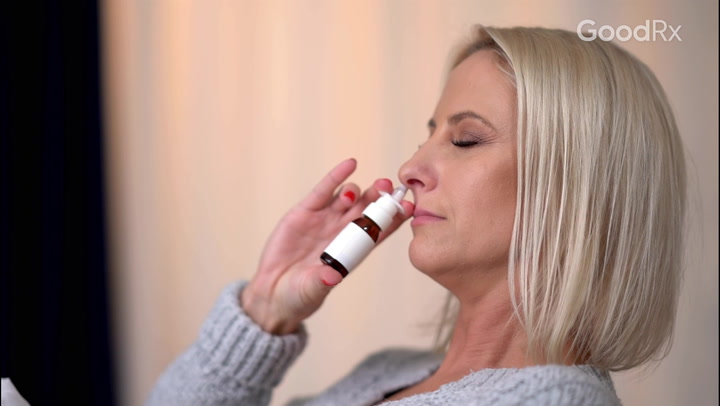
8 Surprising Antihistamine Uses Beyond Allergy Relief
Key takeaways:
Antihistamines are commonly used to treat allergy symptoms. But they’re used for many other symptoms and health conditions, too.
Antihistamines can be taken for sleep problems, acid reflux, and motion sickness. They can also be helpful for menstrual cramps, hives, and nausea relief.
Different types of antihistamines work in different ways. So they can have distinct side effects. Histamine-1 (H1) antagonists (blockers) can cause drowsiness, whereas histamine-2 (H2) blockers might cause headache or diarrhea.
There are ways to save on your antihistamines. Many options are available as lower-cost generics. You can also find ways to make your prescription more affordable with the help of GoodRx.
Access savings on related medications

Antihistamines are a popular treatment option for allergies. Well-known examples include diphenhydramine (Benadryl), loratadine (Claritin), and fexofenadine (Allegra). But the heartburn medication famotidine (Pepcid) is also a type of antihistamine.
Antihistamines can treat a wide range of conditions and symptoms, from sleep issues to acid reflux. Below, we review eight antihistamine uses beyond allergy relief.
What are antihistamines and what do they do?
Antihistamines are a group of medications that block histamine’s activity in the body. Histamine is a natural chemical in our bodies that has many functions. These functions include producing allergic symptoms, balancing your sleep-wake cycle, and making stomach acid.
Types of antihistamines
Antihistamines are split into two main groups: histamine-1 (H1) and histamine-2 (H2) antagonists (blockers). H1 blockers are what most people think of when they hear the word “antihistamines.” These medications help with allergies, motion sickness, sleep problems, and more.
H1 blockers can be further split into first-, second-, and third-generation antihistamines. First-generation (older) antihistamines, such as diphenhydramine, pass more easily into your brain and nervous system. This is why they typically cause side effects like drowsiness and dizziness.
Second- and third-generation (newer) antihistamines don’t pass into your brain or nervous system as easily. This is why many of them are marketed as nondrowsy antihistamines. Loratadine and fexofenadine are examples of second- and third-generation antihistamines.
Save on the top 10 pet medications
Save big on common pet medications like Fluoxetine and Levetiracetam at your local pharmacy.

GoodRx is NOT insurance. GoodRx Health information and resources are reviewed by our editorial staff with medical and healthcare policy and pricing experience. See our editorial policy for more detail. We also provide access to services offered by GoodRx and our partners when we think these services might be useful to our visitors. We may receive compensation when a user decides to leverage these services, but making them available does not influence the medical content our editorial staff provides.
H2 blockers treat stomach-related conditions, like acid reflux. Common H2 blockers include famotidine (Pepcid) and cimetidine (Tagamet).
What can you use antihistamines for?
You’ll find antihistamines marketed to treat a variety of conditions and symptoms. Here, we’ll review eight notable antihistamine uses.
1. Sleep
Taking an antihistamine for sleep is an example of using a medication side effect to your advantage. The sedating side effects of antihistamines have been known since the early 1900s. During this era, researchers discovered that histamine promotes wakefulness and blocking it has the opposite effect.
Sleepiness is more common with first-generation antihistamines. Antihistamines need to pass through the blood-brain barrier — cells that protect the brain from certain substances — to cause drowsiness. As mentioned above, first-generation antihistamines can do this more easily.
All first-generation antihistamines can cause drowsiness. But the two that are marketed for sleep problems are:
Diphenhydramine (ZzzQuil)
Doxylamine (Unisom SleepTabs)
Comparing options: Pharmacists list some of the most common antihistamines, plus what sets them apart from each other.
What to expect: Drowsiness and headaches are just some of the notable antihistamine side effects.
Is there a nondrowsy Benadryl? No. But here, you’ll find information on nondrowsy antihistamines that you may want to consider.
Taking antihistamines for sleep isn’t the best choice for everyone. And experts don’t recommend taking them to treat long-term sleep problems. You shouldn’t take antihistamines for sleep for more than 2 weeks in a row for this reason. If you’re having long-term sleep issues, talk to a healthcare professional.
2. Cold symptoms
By themselves, antihistamines don’t offer significant benefits for treating the common cold. But when taken alongside with other medications, such as decongestants, they might help. One review found that, in adults, antihistamines were helpful during the first day or two of experiencing cold symptoms. But evidence regarding their use in children is lacking.
A few combination cold products that contain an antihistamine (in bold) include:
Coricidin Maximum Strength Flu (acetaminophen / chlorpheniramine / dextromethorphan)
Robitussin Honey Severe Cough, Flu + Sore Throat Nighttime (acetaminophen / diphenhydramine)
NyQuil Cold and Flu (acetaminophen / dextromethorphan / doxylamine)
Theraflu Flu Relief Max Strength Nighttime (acetaminophen / chlorpheniramine / dextromethorphan)
Read more like this
Explore these related articles, suggested for readers like you.
Many cold medications labeled for nighttime use contain a first-generation antihistamine, since they can cause drowsiness. This may help you sleep while you’re sick. This group of antihistamines is also thought to suppress the cough center in your brain. This may help quiet a cough while you’re sleeping.
3. Motion sickness
A few antihistamines work well to treat and prevent symptoms of motion sickness. They’re thought to work by blocking histamine and another chemical called acetylcholine in your brain’s vomiting center, which helps you feel less queasy. Since the medication needs to pass into the brain to have this effect, only first-generation antihistamines can help with motion sickness.
Antihistamines used to treat motion sickness include:
Diphenhydramine
Dimenhydrinate (Dramamine)
Meclizine (Antivert, Bonine, Dramamine Less Drowsy)
Promethazine (Promethegan)
Most antihistamines used to treat motion sickness are available over the counter (OTC). But promethazine and higher doses of meclizine require a prescription. It’s best to take your dose before traveling if you can, since it can take 30 to 60 minutes to start working.
4. Nausea and vomiting
Similar to treating motion sickness, first-generation antihistamines can help relieve nausea and vomiting. As mentioned, these medications block histamine and acetylcholine from triggering the vomiting center in the brain. This can be particularly helpful when it comes to morning sickness.
Doxylamine is a preferred medication for nausea and vomiting during pregnancy. Doxylamine is available OTC by itself. It also comes combined with vitamin B6 in a prescription-only medication (Diclegis, Bonjesta).
Most antihistamines are generally considered safe to take during pregnancy. If you can’t take doxylamine, ask your prenatal care team for alternatives. They may suggest meclizine, diphenhydramine, or promethazine, depending on your situation.
5. Acid reflux
If you’ve ever had acid reflux, you might have tried an H2 blocker like famotidine. These medications stop histamine from signaling certain cells in the stomach to make more acid.
OTC H2 blockers are used to prevent and treat occasional symptoms of acid reflux, such as heartburn. Higher-dose H2 blockers require a prescription, since they’re used to treat conditions that require medical supervision, like ulcers and gastroesophageal reflux disease (GERD).
6. Menstrual cramps
An antihistamine called pyrilamine is in some OTC menstrual relief products, such as Pamprin and Midol. Research suggests histamine plays a role in period cramps. And blocking histamine appears to lessen the intensity of cramps.
There aren’t many studies looking at whether other antihistamines help with menstrual cramps. So more research is needed in this area.
7. Hives
When your body is exposed to certain triggers, immune cells release several chemicals, including histamine. Histamine then acts on your blood vessels and nerves and may cause itchy, red bumps known as hives. Blocking histamine can help relieve this symptom.
First-generation antihistamines used to be commonly recommended for hives. But now, second- and third-generation antihistamines are the preferred treatments. This is because they have lower risks for side effects and work well to treat hives.
8. Anxiety
No OTC antihistamines are approved to help treat anxiety. But the prescription-only antihistamine hydroxyzine (Vistaril) may be an effective option for some people.
It’s not fully clear how hydroxyzine helps with anxiety. It might be because it also affects the activity of other chemicals, such as serotonin, in the brain.
Keep in mind, hydroxyzine isn't a first-choice option for treating anxiety. But your healthcare team may suggest it if other medications aren’t working or if you can’t tolerate them.
How to save on antihistamines
There are many ways to save on your antihistamine. GoodRx can help you navigate your options, which may include GoodRx coupons, copay savings cards, and patient assistance programs.
You can also save with GoodRx by having a healthcare professional write you a prescription for your OTC antihistamine. You may be able to find H1 antihistamine prices as low as $4 and H2 antihistamine prices as low as $9 with a free GoodRx coupon.
Frequently asked questions
Antihistamine side effects vary depending on which type of antihistamine you’re taking. All antihistamines can cause headaches as a side effect.
First-generation antihistamines commonly cause drowsiness and dizziness. Constipation and dry mouth are also possible. Second- and third-generation antihistamines are less likely to cause these issues. H2 blockers can sometimes cause mild digestive-related side effects, such as nausea or stomach pain.
Many people can safely take antihistamines. But each antihistamine has different risks. Ask a healthcare professional if these medications would be OK if you:
Want to give antihistamines to a child
Have glaucoma
Have difficulty urinating due to an enlarged prostate
Take other medications that cause drowsiness, such as opioids or sleep medications
Drink alcohol regularly
Antihistamine interactions vary widely and depend on which one you’re taking. But in general, you should avoid taking H1 antihistamines with medications or substances that cause drowsiness. Combining them can cause excessive drowsiness. You should also avoid combining multiple antihistamines without a healthcare professional’s OK. Taking too many antihistamines can raise the risk of serious side effects, such as seizures or irregular heart rhythms.
The bottom line
Antihistamines have many uses other than treating allergies. But some antihistamines work better for certain symptoms than others. Histamine-1 (H1) blockers can be used for conditions and symptoms like sleep issues, motion sickness, and menstrual cramps. Histamine-2 (H2) blockers can treat stomach conditions related to too much stomach acid.
Among H1 blockers, first-generation antihistamines cause more drowsiness compared to second- and third-generation antihistamines. A healthcare professional can help you decide if an antihistamine is a good option to treat your symptoms.
Why trust our experts?



References
Church, D. S., et al. (2011). Pharmacology of antihistamines. World Allergy Organization Journal.
De Sutter, A. I., et al. (2015). Antihistamines for the common cold. Cochrane Database of Systematic Reviews.
Ebell, M. H. (2004). Antihistamines for the common cold. American Family Physician.
Grattan, C. (2012). The urticarias: pathophysiology and management. Clinical Medicine.
Haleon US Holdings LLC. (2024). Robitussin honey severe cough, flu plus sore throat nighttime - acetaminophen and diphenhydramine hydrochloride solution [package insert]. DailyMed.
Haleon US Holdings LLC. (2024). Theraflu flu relief max strength nighttime - acetaminophen, chlorpheniramine maleate, dextromethorphan hbr syrup [package insert]. DailyMed.
Kovacova-Hanuskova, E., et al. (2015). Histamine, histamine intoxication and intolerance. Allergologia et Immunopathologia.
Patel, R. H., et al. (2023). Biochemistry, histamine. StatPearls.
Sateia, M. J., et al. (2017). Clinical practice guideline for the pharmacologic treatment of chronic insomnia in adults: An American Academy of Sleep Medicine clinical practice guideline. Journal of Clinical Sleep Medicine.
Schaefer, T. S., et al. (2024). Antiemetic histamine H1 receptor blockers. StatPearls.
Schmal, F. (2013). Neuronal mechanisms and the treatment of motion sickness. Pharmacology.
Sicari, V., et al. (2023). Diphenhydramine. StatPearls.
Thakkar, M. M. (2012). Histamine in the regulation of wakefulness. Sleep Medicine Reviews.
Zuberbier, T., et al. (2021). The international EAACI/GA²LEN/EuroGuiDerm/APAAACI guideline for the definition, classification, diagnosis, and management of urticaria. Allergy.





























